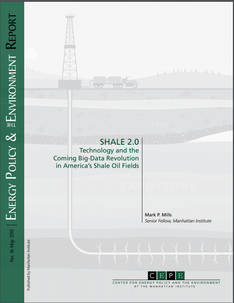|
American Energy Society has selected Mark Mills as Energy Writer of the Year 2016, for his literary contributions to the energy sector, especially his article Shale 2.0.
|

The American Energy Society first took notice of Mills in 2015 with his essay, Shale 2.0, a compelling discussion about the cause and context of the shale oil and gas revolution. In 2016, Mills wrote a series of thought-provoking articles, including his favorite—and that of the American Energy Society—titled, “Drone ‘Coincidenzas:’ Marilyn, Reagan & North Dakota,” which was featured in 360 Review magazine. In recognition of Mr. Mills’ work, the American Energy Society is pleased to feature:
Shale Wars: Oil Prices & Saudi Arabia’s Big Bet |
|
(University of Mary) – What we’re witnessing is a two-part test. The first question is how much damage have low oil prices caused America’s shale industry. Then the second and far more critical part of the test: As oil prices rise, will the shale industry limp or roar back? If it roars back, high oil prices are history. Odds are now that in 2017 we will witness—along with the oil princes of Arabia—the outcome. However it goes, the economic and geopolitical implications are enormous. And the outcome has more to do with technology than with politics.
Nothing Is Bigger Than Oil But before delving into all that, some underlying realities: This is no small battle. Oil is the world’s biggest traded commodity, bigger than all the minerals and metals combined, bigger than agriculture. And despite decades of hype, hope and subsidies, petroleum fuels 95 percent of the machines used to move all people and all goods for all purposes, trade included. The world today uses more oil than at any other time in history and every forecast—including a recent lamentation about this reality from the International Energy Agency—predicts demand will increase for the usefully foreseeable future. And of deep geopolitical relevance, of the world’s five economic regions that account for 75 percent of global GDP—Europe, China, India, Japan and North America—four of them will see rising dependency on petroleum imports. North America, especially the United States, is the outlier with exactly the reverse trend. As for the Saudi experiment, it distills to answering a basic question: Was the astonishing growth in American shale oil production a one-time artifact of high oil prices then and new ‘discoveries’ (i.e., a bubble), or was it the sign of a permanent secular shift in petroleum technology? If the first answer is correct, those who hope for, or need, a world in which oil is expensive will take comfort. That camp includes the oil producing oligopolies and kleptocracies around the world as well as many Western governments, some businesses and green lobbies that are betting on alternatives to oil (from biofuels to batteries) that can only compete at high oil prices. The first part of the experiment, to see how many of America’s new shale producers could survive a financial drubbing, began in 2014. Oil started its collapse from a $105 a barrel peak in that summer, triggered by the fact that American shale producers added more oil to world markets in a shorter time than at any time in history, creating a several million barrel per day over-supply. In the oil-trading world, getting wrong the over- or under-supply by just one million barrels per day can rock markets. Then late in 2014 with prices down 40 percent—a decline that represented a $400 billion annual loss for OPEC—Saudi Arabia increased its oil production by nearly one million barrels per day to drive prices even lower, rather than try to shore up prices by cutting output. Prices went into free-fall, bottoming out briefly just below $30 at the beginning of 2016. Big Gambles, Big Risks This big gamble by the Saudis made sense considering that, unlike the traditional oil business, the shale hydrocarbon industry is so new, barely a decade old, and there is no history to go on for predicting price-response behavior. And because the shale ecosystem is made up of thousands of small and mid-sized enterprises, the biggest of which are a fraction of the size of the super-majors, there is no easy way to get “into the heads” of the operators to predict behavior, unlike the long history of generally predictable responses from big-company executives. The results of the first part of the experiment are now known. Over the 30 months of declining prices, the number of shale drilling rigs in operation collapsed nearly four-fold, and about one-third of the companies in the shale business went bankrupt or became seriously financially distressed. And shale oil production did decline; but so far only about 12 percent off the 2015 peak. Meanwhile, even during the glut-induced financial storm, shale technology just kept getting better. Average productivity—the amount of oil produced per rig—was up 20 percent last year alone, while drilling costs stayed flat or declined slightly. The lesson from the first half of the experiment is thus clear: A price drubbing achieved only modest production declines and did nothing to slow and arguably accelerated the radical technology gains in the cost-effectiveness of shale drilling. Put another way, the Saudis have seen that the amount of money needed to add more American supply keeps shrinking and is moving monthly closer to the Middle East’s vaunted low-cost advantage. At the current tech-driven growth rate, output per rig will double every 3.5 years. That kind of progress is normally seen in Silicon Valley. For consumers it’s exciting, but not so much for shale’s competitors. Bounce Back in Shale Production Now comes part two of the experiment. As prices creep back up—an inevitability as world demand keeps growing, while global investments in production have everywhere pulled back in the face of low prices—just how quickly will American shale production rise this time? We know the answer: fast. We’re about to find out just how fast. The number of oil rigs nationwide peaked in October 2014 at 1,609 and then fell rapidly to 316 in May 2016 as oil prices collapsed. The number of drilling rigs then increased by 150 percent to 789 by March 17, 2017. Given how much more productive today’s rigs are, it won’t take much more of a rig count rise to produce world-shaking results. Given what we know from very recent history, it’s reasonable to think that the shale industry today could grow again at least as fast as it did from its inception, circa 2005, when shale companies went on to more than double U.S. production in a handful of years. And that happened using technology that was literally half as good as what exists now, and with operators who then had to learn on-the-fly to use techniques for which there was no prior experience. That industrial ecosystem now has fantastically better technology, deep experience and a pre-built infrastructure. One might pay attention to what shale pioneer Harold Hamm, Continental Resources founder and CEO, said earlier this year about U.S. oil production: “We’ve doubled it. We can double it again.” At the core of the experiment is a test of the four key characteristics of shale that differ radically from the traditional oil business and that account for shale’s past and future velocity:
Shale 2.0 Boom? The bottom line? We, and the Saudis, will witness in 2017 the dual-edged sword of the new shale dynamics. Oil prices are on track to creep back to the $60 to $70 range next year. At those prices shale activity will start to resemble a stampede rather than the cautious tiptoe back that’s already underway at today’s about $50 price point. But the resulting bump in output will oversupply markets again, even more rapidly than last time. That will push prices back down again. In short, the world is now entering a long period of fast-cycling relatively low oil prices. Consumers are the winners in producer price wars—provided the marketplace of suppliers doesn’t contract to the point of leaving a monopoly or oligopoly with the power to engage in predatory pricing once the competition has been cleared out. So far, the oligopolists haven’t managed to eliminate the shale competition. That’s where politics intersects markets. The Saudis have behaved quite rationally by any business standard. It’s an ancient practice to use price discounts to gain or retain market share. It is an equally old practice to use (sometimes honestly and publicly engineered) price manipulation to try and drive competitors out of business. But, as they say, politics can make strange bedfellows. It is fair to observe that environmentalists and oil oligarchs (a.k.a. the actual “big oil” guys) have the same interest in stifling a shale 2.0 resurgence. Look no further than the high-profile, anti-shale protests over the Dakota Access pipeline, which is intended to carry Bakken shale oil to markets. On the other side are consumers around the globe who benefit from the new world oil order, not to mention the millions of Americans whose jobs are associated with the shale boom, and the collateral economic benefits and trade spillovers. The wild cards now: Will anti-shale forces, through protests, lobbying and legal actions, successfully stifle a shale 2.0 boom? Or will President Donald Trump, through regulatory relief and favorable tax and trade policies, help those thousands of producers crank open the spigot? We will see the answer and the outcome of the grand Saudi experiment in the coming months. |
About the award
|
According to Eric Vettel, president of American Energy Society, “The breadth of talent that supports energy is remarkable. But what sets Mills apart is his ability to make difficult topics in energy more accessible, and his extraordinary skill in capturing scale, his deep awareness of technological innovation, and his unique ability to step back and provide critical context.“
|
About the author
|
Mark P. Mills is a senior fellow at the Manhattan Institute, faculty fellow at Northwestern’s McCormick School of Engineering and Applied Science, and an advisory board member of Notre Dame University’s Reilly Center for Science, Technology, and Values. Mills is trained as an experimental physicist and development engineer, and holds a degree in physics from Queen’s University in Ontario, Canada. Mills is a regular contributor to Forbes.com and is author of Digital Cathedrals (2020) and Work in the Age of Robots (2018). He is also coauthor of The Bottomless Well: The Twilight of Fuel, the Virtue of Waste, and Why We Will Never Run Out of Energy (2005).
|
Other awardees
|
2023: Philip Verleger and Kim A. Pederson »
2022: Amy Harder » 2021: Katharine Hayhoe » 2020: Daniel Yergin » 2019: Vaclav Smil » 2018: Nathaniel Rich » 2017: Meghan O'Sullivan » 2015: Coral Davenport » |
|
|





